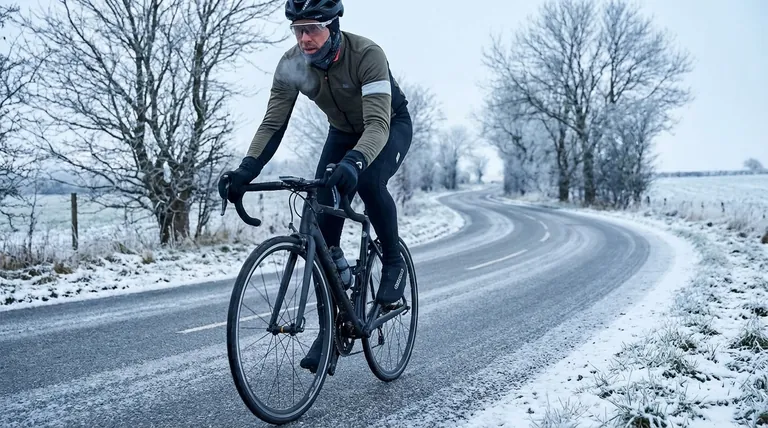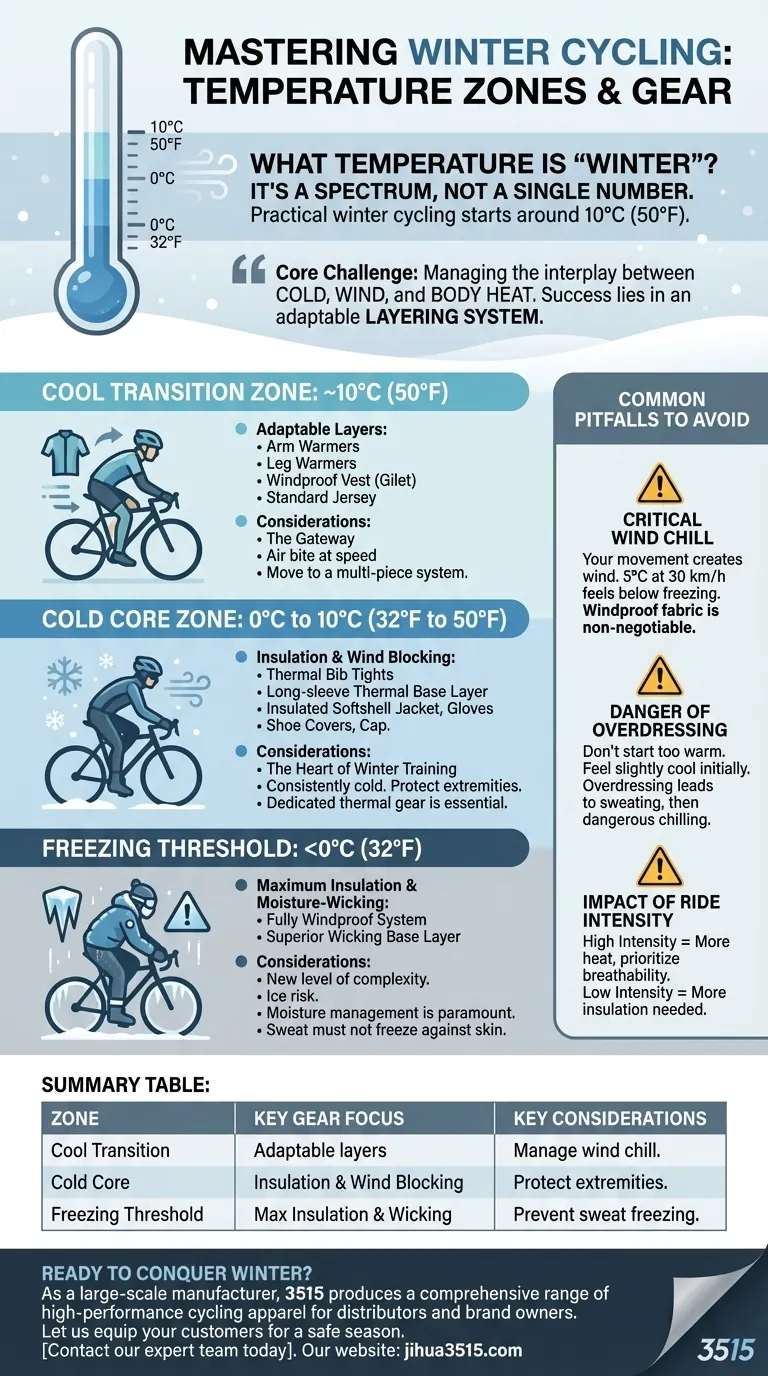The definition of "winter cycling" is a range, not a single number. While conditions below freezing (0°C / 32°F) are definitively considered winter, the practical temperature range begins much higher, around 10°C (50°F). This is the point where standard cycling gear becomes insufficient and a more thoughtful, layered approach is required.
The core challenge of winter cycling is not the temperature itself, but managing the interplay between the cold, wind, and the heat your body produces. Success lies in an adaptable layering system, not just one thick jacket.

Deconstructing the "Winter" Temperature Spectrum
To prepare effectively, it's best to think of "winter" not as one season, but as distinct temperature zones, each with its own set of rules and gear requirements.
The Cool Transition Zone: ~10°C (50°F)
This temperature is often considered the gateway to winter riding. While not frigid, the air has a significant bite, especially at speed.
This is where you move from single layers to a multi-piece system. Think arm warmers, leg warmers, and a windproof vest (gilet) over your standard jersey.
The Cold Core Zone: 0°C to 10°C (32°F to 50°F)
This is the heart of winter training for most cyclists. Conditions are consistently cold and demand dedicated thermal gear.
Your strategy here shifts to insulation and wind blocking. Thermal bib tights, a long-sleeve thermal base layer, and an insulated, windproof softshell jacket become standard. Protecting your extremities with quality gloves, shoe covers, and a cap under your helmet is critical.
The Freezing Threshold: Below 0°C (32°F)
Riding below freezing introduces a new level of complexity and risk. Ice on the road becomes a primary concern, and gear failure can have more serious consequences.
Moisture management is paramount. Sweat that gets trapped against your skin can freeze, leading to rapid and dangerous chilling. Your layering system must be exceptionally good at wicking moisture away from your body while providing maximum insulation.
Common Pitfalls to Avoid
The number on the thermometer is only part of the story. Newcomers to cold-weather riding often make mistakes by ignoring other critical environmental factors.
The Critical Role of Wind Chill
Your movement creates its own wind. A calm 5°C (41°F) day can feel like it's below freezing when you're riding at 30 km/h (18 mph).
This is why windproof fabric on the forward-facing panels of jackets and tights is non-negotiable. It prevents convective heat loss, which is the primary way you get cold on a bike.
The Danger of Overdressing
It's tempting to put on your heaviest layers from the start, but this is a classic mistake. You should feel slightly cool when you first step outside.
Your body will generate a tremendous amount of heat once you start pedaling. Overdressing leads to excessive sweating, and a wet base layer will make you dangerously cold the moment you slow down or stop.
The Impact of Ride Intensity
The gear you need for a high-intensity training session is different from what you need for a long, slow endurance ride.
More effort equals more heat. For intense rides, prioritize breathability and wicking. For slower rides, you can opt for slightly more insulation.
Making the Right Choice for Your Goal
To prepare effectively, choose your approach based on the specific temperature and your ride's objective.
- If your primary focus is riding in cool weather (5-10°C / 41-50°F): Focus on adaptable layers like arm warmers, a gilet, and a light base layer that you can adjust or remove as you warm up.
- If your primary focus is riding in cold weather (0-5°C / 32-41°F): Prioritize a thermal jacket, insulated tights, and complete protection for your hands, feet, and head.
- If your primary focus is riding below freezing (<0°C / 32°F): Your system must be fully windproof and insulated, with a significant focus on wicking sweat away from your skin to prevent dangerous chilling.
By understanding these principles, you can transform winter from a barrier into a new season for productive and enjoyable cycling.
Summary Table:
| Temperature Zone | Key Gear Focus | Key Considerations |
|---|---|---|
| Cool Transition (~10°C / 50°F) | Adaptable layers (arm/leg warmers, gilet) | Standard gear becomes insufficient; manage wind chill. |
| Cold Core (0°C to 10°C / 32°F to 50°F) | Insulation & wind blocking (thermal tights, softshell) | Protect extremities; dedicated thermal gear is essential. |
| Freezing Threshold (<0°C / 32°F) | Maximum insulation & moisture-wicking base layers | Ice risk; prevent sweat from freezing against skin. |
Ready to Conquer Winter on Two Wheels?
Cycling in cold weather requires the right gear to manage body heat, block wind, and wick moisture effectively. As a large-scale manufacturer, 3515 produces a comprehensive range of high-performance cycling apparel for distributors, brand owners, and bulk clients. Our production capabilities encompass all types of technical jackets, bib tights, base layers, and accessories designed for the specific demands of winter cycling.
Let us help you equip your customers for a safe and productive season. Contact our expert team today to discuss your cycling apparel needs.
Visual Guide

Related Products
- Durable Mid-Cut Tactical Boots for Wholesale & Private Label
- Wholesale Durable Mid-Cut Tactical Boots for Custom & Private Label Brands
- Wholesale Classic Leather Lace-Up Ankle Boots for Brand Manufacturing
- Durable Leather Work Boots for Wholesale & Custom OEM Manufacturing
- Wholesale High-Traction Camo Boots - Custom Manufacturer for Brands
People Also Ask
- Why has Cordura remained relevant despite new fabrics? The Unbeatable Balance of Durability & Comfort
- How does the initial cost of tactical boots compare to regular shoes? Understand the Value Behind the Price
- How do tactical boots and combat boots differ in flexibility? Agility vs. Armor Explained
- What are the primary differences between tactical boots and combat boots? Choose the Right Boot for Your Mission
- Why is maintenance important for work boots? Protect Your Investment and Safety

















